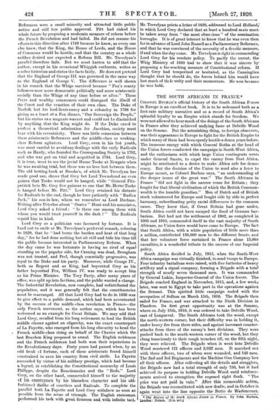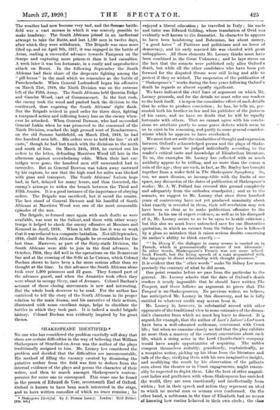THE SOUTH AFRICANS IN FRANCE.*
COLONEL Buenaav's official history of the South African Forces in Europe is an excellent book. It is to be welcomed both as a first-rate military narrative and as a record of South Africa's splendid loyalty to an Empire which stands for freedom. We were not allowed to hear much of the doings of the South Africans in France after they achieved undying fame at Delville Wood on the Somme. But the astonishing thing, to foreign observers, was their appearance in Europe to fight for the British Empire to which many of them had been openly hostile a dozen years before. The immense energy with which General Botha at the head of the Union forces conducted the campaign in South-West Africa, and the enthusiasm with which large Union contingents went, under General Smuts, to expel the enemy from East Africa, might be attributed to a desire to make Africa safe for demo- cracy. But the decision of the Union to send also a force to Europe meant, as Colonel Buchan says, "an understanding of the deeper issues of the great war." The South Africans in France "did not fight in the narrow sense for Britain ; they fought for that liberal civilization of which the British Common- wealth is the humble guardian." Men of Dutch and of British stock volunteered for Europe and fought side by side in perfect harmony, subordinating petty racial differences to the common cause. They knew that, if Great Britain had gone under, South Africa could not have escaped the flood of German bar- barism. But had not the settlement of 1902, as completed in 1906 and 1910, commended itself to the vast majority of South Africans, no Union force would have come to Europe. The fact that South Africa, with a white population of little more than a million, contributed 136,000 men to the different fronts, and that her volunteer force sustained in France alone 15,000 casualties, is a wonderful tribute to the success of our Imperial policy.
South Africa decided in July, 1915, when the South-West Africa campaign was virtually finished, to send troops to Europe. Four infantry battalions were raised, with five batteries of heavy artillery and a signal company, forming a Brigade with a total strength of nearly seven thousand men. It was commanded by General Lukin, Inspector-General of the Union forces. The Brigade reached England in November, 1915, and, a few weeks later, was sent to Egypt to take part in the operations against the Senussi. This spirited little campaign ended with the occupation of Sollum on March 15th, 1916. The Brigade then sailed for France, and was attached to the Ninth Division in Flanders. Its first great opportunity was at the Somme, where on July 15th, 1916, it was ordered to take Delville Wood, east of Longueval. The South Africans took the wood, except the north-western corner, but their difficulty was in holding it, under heavy fire from three aides, and against incessant counter- attacks from three of the enemy's best divisions. They were pushed back to the south-western corner of the wood, but they clung tenaciously to their rough trenches till, on the fifth night, they were relieved. The Brigade when it went into Delville Wood mustered 121 officers and 3,032 men. It marched out with three officers, two of whom were wounded, and 140 men. The 2nd and 3rd Regiments and the Machine Gun Company lost all their officers. After collecting all the details and stragglers, the Brigade new had a total strength of only 750, but it had achieved its purpose in holding Delville Wood until reinforce- ments arrived to strengthen the exposed right flank. "The price was not paid in vain." After this memorable action. the Brigade was reconstituted with new drafts, and in October it again weut into the line opposite the Butte de Warlencourt.
• Th8 His'ory of 1/43 Sow* African Forces se France. By Sohn Buchan.
Louden.: Nelson. L1iL net.1
The weather had now bectune very bad, and the Some battle:. field was a vast morass in which it was scarcely possible to make headway.- The South Africans joined- in an ineffectual attempt to take the Butte, and lost 1,150 men in twelve days, after which they were withdrawn. The Brigade was once more filled up, and on April 9th, 1917, it was engaged in the battle of Arras, making a successful advance towards Fampoux on the Scarpe and capturing more prisoners than it had casualties. A week later it was less fortunate, in a costly and unproductive attack on Rceux. In the following September the South Africans had their share of the desperate fighting among the " pill-boxes" in the mud which we remember as the battle of Passchendaele. When General Ludendorff began his offensive on March 21st, 1918, the Ninth Division was on the extreme left of the Fifth Army. The South Africans held Quentin Ridge and Gauche Wood, east of Gouzeaucourt. In the first rush, the enemy took the wood and pushed back the division to the southward, thus exposing the South Africans' right flank. But the Brigade retired in good order for three days, fighting a rearguard action and inflicting heavy loss on the enemy when- ever he attacked. When General Dawson, who had succeeded General Lukin when he was promoted to the command of the Ninth Division, reached tha high ground west of Bouchavesnes, on the old Somme battlefield,. on March 23rd, -1918, he had five hundred men left. His-orders were to hold the line "at all costs," though he had lost touch with the divisions to the north and south of him. On March 24th, 1918, he carried out his orders to the letter, defending MarriOres Wood till late in the afternoon against overwhelming odds. When their last car- tridges were gone, the hundred men still unwounded had to surrender. But as General Dawson was taken away eastward by his captors, he saw that the high road for miles was blocked with guns and transport. The South Africans' forlorn hope had, in fact, delayed for many hours, and thus thwarted, the enemy's attempt to widen the breach between the Third and Fifth Armies. It is a good instance of the importance of obeying orders. The Brigade was sacrificed, but it saved the armies. The last stand of General Dawson and his handful of South Africans at Marrieres Wood was one of the most memorable episodes of the war.
The Brigade, re-formed once again with such drafts as were available, was sent to the Salient, and there with other weary troops it helped to check the enemy offensive at Messines and Kemmel in April, 1918. When it left the line it was so weak that it was reduced to a composite battalion. Not till September, 1918, Auld the South African Brigade be re-established for the last time. However, as part of the Sixty-sixth Division, the South Africans were able to join in the final advance. In October, 1918, they did well in the operations on the Beaurevoir line and at the crossing of the Selle at Le Cateau, which Colonel Buchan shows to have been a far more serious affair than we thought at the time. In this advance the South Africans alone took over 1,200 prisoners and 22 guns. They formed part of the advance guard, and when the Armistice took effect they were about to occupy Sivry, east of Avesnes. Colonel Buchan's account of these closing movements is new and interesting. But the whole book deserves to be read. For the author has contrived to tell the story of the South Africans in its proper relation to the main drama, and his narrative of their actions, illustrated with some excellent, maps, helps to elucidate the battles in which they took part. It is indeed a model brigade history. Colonel Buchan was evidently inspired by his great theme.



































 Previous page
Previous page